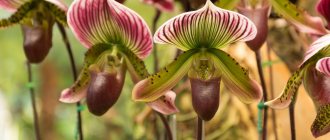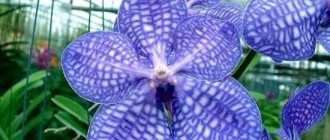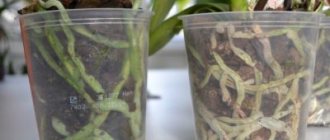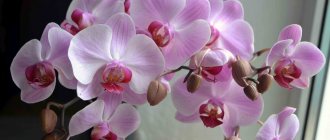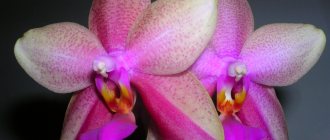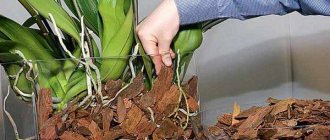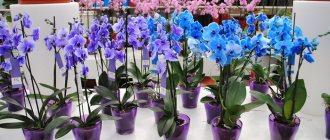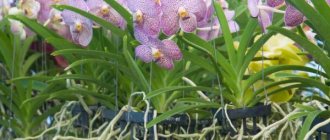Reproduction
Phalaenopsis Orchid
To propagate orchids, the seed method is used, propagation by children and layering, that is, vegetatively. Only experienced collectors can obtain new specimens through cloning.
Seed method
Orchid from seeds
The main condition for seed germination is nutritious soil. And it can only be obtained in a laboratory setting. Here you can achieve sterility.
If someone at home decides to undertake this labor-intensive process - germinating seeds, you need to prepare yourself for the fact that this is a long process and it takes 9 months.
Rastuski grow for 3 years, and only after 4 years can you see the flowering of phalaenopsis. Some flowers do not want to please their owner and do not bloom for 10 years.
Let's look at the process step by step. Seeds should be placed in prepared moist soil consisting of moss and leafy soil and the bowl should be covered with glass. There should be drainage at the bottom. Germination requires high temperature and humidity.
Picking is carried out with tweezers when one leaf develops on the seedlings. Planting in separate pots - after 4 leaves appear on the plant.
How to propagate by cuttings?
Dividing shoots into cuttings
To propagate by cuttings, you need to choose a plant that has only one growth point.
Cuttings should be taken from a healthy mother plant; damaged cuttings can be discarded. Brown spots on the stems of indoor orchids most often indicate that non-infectious or fungal diseases are present, and may be a sign of rot or spotting.
The shoots should only be cut with sharp pruning shears; scissors can damage the internal tissue. The bottom cut must be sprinkled with crushed crushed coal.
When rooting, the bottom of the container should be filled with drainage material. These can be pieces of foam plastic, small fractions of expanded clay, sphagnum moss. You can fill it with pebbles.
All planted cuttings must be covered with polyethylene or a plastic container placed in a greenhouse in which the necessary microclimate will be created. Orchids will grow and develop well.
Plantings should be watered using a spray bottle with warm water, avoiding waterlogging of the soil. Excessive waterlogging will cause rot.
Planting children
The baby appeared on the peduncle
Only some phalaenopsis grown in suitable conditions can produce lateral shoots - babies. They should be separated from the adult specimen carefully, otherwise they will not produce their own roots. To obtain planting material, mother plants must be kept in a room with high temperature.
And also to obtain them it is necessary to apply fertilizers with a high concentration of nitrogen.
After the baby is born, she needs to be protected. And when your root appears, carefully separate it, treat the cut with charcoal and transplant it into a new pot.
Cloning
Orchid
Propagating an orchid by cloning is something only scientists can do. No one can do it at home.
All work on preparing material for propagation is carried out under a microscope in the laboratory. The taken cells are placed in a nutrient mixture. When the nutrient medium turns into clots, it is replaced with a new one. Cell division results in many plants.
A good way to do business selling flowers.
Growing garden blackberries - a description from purchasing a seedling and planting it in open ground to caring for and harvesting from the Moscow region to Siberia (Photo & Video) + Reviews
Step-by-step care instructions
Selecting a location
This orchid is very afraid of the open rays of the sun. Experienced collectors are advised to place it on north-facing windows, adding lighting.
Preparing the soil and pot
It is better to take a transparent plastic pot; we make small holes in the sides and bottom for good air access and for a convenient location of the roots. The pot does not need to be very large, but rather to support the roots, so choose medium sized pots.
Substrate:
- Drainage - pieces of polystyrene foam or expanded clay located at the bottom of the pot.
- Charcoal – crushed pieces can be placed in the moss between the roots.
- moss retains moisture well and is a natural environment for orchids.
Temperature
The orchid is thermophilic, it is advisable that the temperature does not drop below 20 ° C during the day, no matter what time of year it is outside. Then it will develop well, grow, grow young leaves and soon bloom again.
Important : Sogo Orchid does not like heat, the optimal temperature is up to 28 ° C.
Humidity
Sogo orchids do not require too much moisture, 50-60% is enough . They tolerate drying better than flooding. But in spring and summer it is necessary to increase air humidity. This will ensure good growth and flowering of orchids. Additional moistening is not required; it is enough to simply refresh the leaves in hot weather by spraying.
Lighting
The Sogo orchid, like all hybrid varieties of Phalaenopsis, is not capricious. Does not require any special lighting devices. In spring and summer, be sure to darken the windows so that the sun does not burn the orchid leaves. In winter, additional lighting is required; special phytolamps can be used.
Watering
If the orchids are located on northern windows, naturally, watering is not needed as often as if the orchids were located in a “warmer” window. It is important to watch the roots. If the roots are greyish brown, you can water them .
It is better not to water the flowers or spray them, so that stains do not appear on them, but the leaves can be sprayed, moisturizing the aerial roots. It is enough once every 2 weeks in the autumn-winter period, and if it is very hot, then once a week.
We recommend watching a video about proper watering of an orchid:
Top dressing
Feed your Sogo orchid usually with watering . Flower growers are recommended to water with any special rooting agent. Fertilizer regime: alternating irrigation with plain water and irrigation with fertilizer. As soon as the buds appear, water only with water, without fertilizer. The main thing is to do no harm.
Transfer
- You will need to remove the orchid from the pot, then soak the orchid along with the earth in a solution of epinic and succinic acid. We also soak coconut chips and sphagnum moss.
- It is transplanted using the method of transshipment with the original substrate (if the orchid is healthy).
- If there are diseased, decayed roots, then you will need to clean the roots.
- We lower the renewed and treated orchid into a new pot.
- Fill the space of the pot with the prepared substrate, without pushing it.
- We place the orchid in a large container, water it well so that moisture penetrates the entire new substrate. Excess water gradually drains through the holes. Use a cotton pad to remove water from the leaves and growing points to avoid rotting.
We recommend watching a video about the features of transplanting a Sogo orchid:
Peculiarities
Mini-orchids are herbaceous plants and are considered perennial. In appearance, they resemble ordinary phalaenopsis, only shorter. That is why it is often called dwarf, because it is the smallest orchid in the world. Their main feature is considered to be small flowers, which can create entire inflorescences, or can be located alone on a regular stem. In fact, this plant often looks like a smaller version of a large orchid.
The height of such phalaenopsis is from 12 to 20 centimeters, everything depends directly on the variety. The flowers are small in diameter, some of them reach up to 7 centimeters in size. The number of petals depends on the age of the mini-orchid. There can be up to 15 flowers on the stem at the same time.
Flowering most often begins in winter and can last more than 1 month.
In nature, these beauties can be found in equatorial forests and among rocky areas. Some of them live not only on tree trunks or on their branches, but even on the leaves of evergreen trees. However, breeders are most interested in those mini-orchids that have small roots and pseudobulbs. The most beautiful among them are those plants whose stem length is equal to the diameter of the flower. Such plants simply fascinate with their beauty.
Flowering period
The flowering of Phalaenopsis Singolo, as well as other types of orchids, does not depend on the time of year or seasonality.
This process is directly influenced by the microclimate in which it grows. Flowering duration is usually eight to twelve weeks.
When flowering occurs again, gardeners noted the appearance of two or three new peduncles . For the full development of one flower, characteristic of this species, the remaining peduncles are cut off.
External characteristics
The Royal Phalaenopsis orchid belongs to the giants; the trunk has very tall parts. This is what distinguishes the variety from other representatives of epiphytes from the tropics. Indoor phalaenopsis has the following dimensions:
- The flowers of the trunk are large, each of them can reach a diameter of up to 16 cm. The shape is round, the petals are large, the lip is also rather large;
- the maximum peduncle can grow up to one and a half meters, while the standard is considered to be a meter-long shoot;
- an adult trunk usually has 5-7 leaves on a shortened stem; sometimes it happens that a trunk grows up to 9 leaf blades;
- a fully formed plant can reach a length of up to 1.7 meters, but this happens in rare cases. Usually the trunk with peduncle reaches 1.2-1.4 m.
Interesting! The variety produces one peduncle; there are only enough nutrients for this number of flowers. If you observe a Royal Phalaenopsis with two shoots, it is an extremely rare occurrence.
Description of the plant and photo of the peduncle
The plant has a small peduncle, with 2-3 flowers of a single color on a rosette. This is the first variety of orchid whose petals are painted in one shade. The leaves are located at the base of the pot. They have a dense, fleshy structure. There are also aerial roots through which the plant is watered. Root shoots with a dense structure go deep into the pot. They grow into tree bark and obtain nutrients and minerals from it.
Description
It is not for nothing that the Royal Phalaenopsis orchid bears this name; this variety is truly worthy of a queen.
The standard has impressive dimensions and unusually large and beautiful flowers, and the light delicate smell only confirms its high origin.
The variety was bred in a special way and patented not very long ago. His parents still delight the eyes of the local population in the tropical forests of Australia and Indonesia.
In addition, the same varieties of wild phalaenopsis are distributed throughout almost all of Southeast Asia. It’s not for nothing that locals call the orchid “Queen of the Tropics.”
Royal phalaenopsis has the following characteristics:
- large dimensions of the trunk;
- large flower sizes;
- tall peduncle;
- moderate leaves.
Usually their cost is an order of magnitude higher than that of conventional types, they are not picky about care, and like all orchids they love watering and long-term lighting.
Photo of a blooming Royal Phalaenopsis.
Phalaenopsis Singolo
Phalaenopsis is native to the dense tropical forests of southern Asia (southern India, Taiwan and the Philippines), New Guinea and Australia. This biological species has up to seventy varieties, in addition, there are thousands more different hybrids and varieties. These are plants with greatly shortened stems.
The leaves are evergreen, 10-30 cm long, collected in a rosette from which flower stalks and aerial roots grow. For its color and shape of the petals, similar to the fluttering wings of a butterfly, this flower was called “orchid-moth” or “orchid-butterfly”.
You can find phalaenopsis with a single flower, as well as with many inflorescences that fit on one stem. The stem can reach a length of sixty centimeters and bear up to twenty inflorescences.
Phalaenopsis is the most unpretentious plant of the orchid family, and for beginners it is recommended to breed orchids from it.
Thanks to its lush and frequent flowering and excellent adaptation to indoor conditions, this plant has become the most popular of the genus of orchids grown indoors. Before purchasing, carefully inspect the plant: the roots should be green and silver.
Home care
Mini-orchids require a lot of attention, so if you decide to have such beauty on your windowsill, you need to learn how to properly care for them.
Correct lighting
Like many orchids, these little beauties prefer bright, but diffused light. Therefore, it is best to place them on the western or eastern side.
Temperature and Humidity
The temperature regime for orchids should be approximately the same throughout the year. The minimum temperature for this plant should not be lower than +17–+18 degrees. But the maximum should not exceed +22 degrees. If it is a little lower at night, this will allow it to bloom longer and more beautifully.
Humidity does not matter much during care, but it is still better if it is within 60 percent. When the air is dry, the development of orchids immediately stops.
To increase it, you can purchase special humidifiers or simply place small containers of water in different places.
Substrate selection
Very often, for the good development of this plant, only sphagnum moss is used. However, in some cases, pine bark is added to it, as well as a little charcoal, to prevent the development of rot in the root system. You can buy it at any flower shop.
Proper watering
Since most orchids are grown in a pot with sphagnum moss, the plant needs to be watered daily, because it absorbs moisture quite quickly. However, it is best to simply spray it. For this, 20–40 ml of water will be enough. It must be soft and warm.
In addition, sometimes you can bathe mini-orchids in the shower; the procedure should last at least 10 minutes. The water temperature should be no higher than +35 degrees.
Top dressing
These beauties should be fertilized only 50–60 days after transplantation. In addition, if rot was found on the roots, then it is best to abandon this process. Feeding is carried out after abundant watering of the orchid. In addition, you should not do it when the orchid is blooming. Feeding can be of two types.
Root
Spend more time to stimulate the growth of a small plant. Fertilizer should be applied immediately after watering, placing it directly into the ground. After this, the flower must be moved to a warm place for several hours, avoiding direct rays of the sun.
Foliar
In this case, it is best to dissolve the fertilizer in water and then spray it with a spray bottle. However, this must be done very carefully so that it does not get on the flowers.
If you follow all these rules, the mini-orchid will grow strong and beautiful.
Phalaenopsis Orchid
Phalaenopsis (Phalaenopsis) , belongs to the Orchidaceae (Orchidaceae) family
The most popular Phalaenopsis orchids are known as “butterfly” orchids, with robust, round flowers on thin, long stems that look like moths in flight. Types and varieties of various sizes and shades. Several hundred hybrids have been grown, and phalaenopsis are popular because they are easy to grow and care for at home.
The flowers are odorless, appear up to three times a year, and bloom for several months. They come in striped, variegated, spotted, two-tone and speckled, and pure white. White ones are among the favorite wedding flowers.
Size and color combination depends on origin. Well-known world producers are constantly crossing new varieties to obtain new wonders.
Commercial production is carried out using “in vitro” methods that replicate the characteristics of the mother plants.
The soil
A thick mixture of bark with the addition of charcoal, perlite, pieces of moss or a floral sponge is used as a substrate. Roots will often grow out of the container, completely naturally. Orchids are grown on a piece of bark. The roots are sprayed with water.
Watering
Watering is an important part of caring for phalaenopsis at home. Phalaenopsis loves abundant watering, does not tolerate wet leaves and is constantly in moist soil.
Watering the orchid is done once every 10-14 days in winter (depending on the temperature, warmer - more often, cold - less often), once a week or more often in the summer, watering the roots with warm rainwater or standing water from the tap. The water should not be cold.
Before planting plants in decorative containers, let them drain well. The roots should not stand in water.
Spraying
Simply spraying with clean water several times a week in summer will provide sufficient humidity; in winter, place a few stones on the stand when placing the plant pot and pour water to evaporate.
The best time to spray is in the morning, allowing the water to evaporate before nightfall. Phalaenopsis is able to survive without water if the air humidity remains high.
It is good to wipe the dust from the leaves with a damp cloth, which blocks the flow of light.
Temperature
Regarding temperature, phalaenopsis orchids are excellent houseplants and will grow in a home with central heating. They are heat-loving orchids, growing in the range of 15-28 degrees Celsius, the optimal temperature is approximately 20-22 degrees Celsius.
Reducing the temperature at night for a few days in early autumn stimulates flower shoots to develop more quickly. The minimum temperature below which phalaenopsis die is 12 degrees. Cold drafts should be avoided as they can destroy plants.
Lighting
Phalaenopsis likes to grow in good, diffused light; direct sunlight will burn the leaves. Light stimulates flowering. Will tolerate partial shade during the growing season. In winter, grow in a well-lit place without direct sunlight.
Fertilizer
Fertilizer requirements are moderate. Feed every two weeks in the summer, using half the dose, in the winter once a month, it is better to stop fertilizing. There are special mineral fertilizers for orchids and nutrients based on bird droppings - natural products are the best.
Diseases and pests
Phalaenopsis falls prey to few fungal diseases and pests. The most important thing is proper prevention and monitoring. If alarming symptoms, peeling or brown spots on the leaves are noticeable, the first step is to isolate the samples; bacterial and fungal diseases are easily transferred (spraying water). Plants are installed in a dry place under supervision.
Due to excessive watering and growth in old substrate, the roots of the orchid become infected with wet rot. The phalaenopsis is removed from the ground, dead and diseased roots are cut off, the sections are coated with powdered charcoal, the plant is dried and replanted in a fresh substrate. Do not water temporarily, observing whether the plant is alive. If yes, watering resumes.
Forcing re-blooming
Phalaenopsis can be easily prepared for re-blooming at home. If the specimen is large and strong, the flower stem is green, cut above the node on the trunk - where a small protrusion appears, looks like a small leaf lying flat on the stem. A new shoot will emerge from the node in about a month, flowers will appear in 2-3 months.
//www.youtube.com/watch?v=ORmVVLRLdJ8
If the stem is brown, cut off at the base. Allows the plant to create a new powerful shoot at the roots. It takes longer than with a partial cut (9 months), depending on the growing conditions of the orchid.
If the shoot is half green and half brown, the old stem is cut off just above the node, leaving a piece about 4-5 cm long. The method will allow the plant to produce a new peduncle in a few weeks, which will be shorter and have fewer flowers than on a peduncle from the roots.
Modern hybrids of phalaenopsis orchids are colorful and pleasing to the eye, knowing about caring for phalaenopsis at home, it is worth adding colorful decor to the interior. Phalaenopsis plants are available in flower shops, some garden centers and large supermarkets. Specialized exhibitions are organized.
Source: //floral-house.ru/tsvetushchie/orkhidei/orkhideya-falenopsis.html
The most popular varieties
As we found out, Royal Phalaenopsis refers to the English name “Phalaenopsis Royal...” from the Dutch nursery “Geest Orchideeën” (VG Orchids), which are good at painting their plants in the brightest colors.
Colors of Phalaenopsis Royal.
There are quite a lot of varieties of Royals, but the most popular are:
- Royal Blue Phalaenopsis has sky-colored flowers. The bole usually blooms in a cascade for quite a long time;
- Aphrodite Royal became the prototype of the world's first transgenic blue orchid. It was recently developed by Japanese geneticists. It is not yet available to most gardeners;
- A cascade is an artificially created direction of growth of a peduncle, thanks to which “arches”, “rings” and other flower shapes are obtained.
- Royal Pink is a Japanese derivative. The standard has a different color scheme; the delicate pink color of the flower will not leave anyone indifferent.
Royal pink.
In addition, there are many more varieties, all of them are united by large flowers and colorfulness during the flowering period.
Features of planting varieties with high decorative properties
The stems of the varieties described above can be replanted not only after flowering; some gardeners recommend changing the soil during this period.
The main requirements for the substrate for such phalaenopsis:
- The mixture should contain pieces of bark of different sizes, the ratio of large and small fractions is approximately 8:2;
- Small inclusions of lumps of peat are allowed.
You also need to be able to choose a vessel; a transparent plastic pot is ideal for this. You should take it a little more than the previous one.
To create a more sophisticated design for planting phalaenopsis, you can use clay bowls. But this is provided that you can carry out the correct watering regime without looking at the roots.
The transplant is carried out in the standard way:
- Take the plant out of the pot;
- Free the roots from the old substrate as much as possible;
- Dry and rotten roots are cut off and the cuts are processed;
- Drainage is placed at the bottom of the prepared pot;
- Place the root system of the orchid and carefully distribute the pieces of bark.
You can use clay pots to create an exquisite design. The main thing is not to forget to water on time.
After this, the plant is left alone for 10-14 days, it is not watered, not turned, or fed.
Advice! Before planting in a new substrate, the phalaenopsis rhizome can be fed by soaking it in a special nutrient solution. It can be prepared using store-bought fertilizers or from natural products at home.
Landing
The royal orchid has difficulty adapting to new conditions after transplantation, in light of which it would be more correct to carry out this manipulation with the plant only in extreme cases. This concerns the growth of the root system when the old pot becomes too small for the phalaenopsis. Also, the need for replanting may arise if a root disease is detected.
There are certain recommendations regarding the selection of suitable soil for a tropical flower. First of all, it should not interfere with the flow of air to the root system, nor should it retain moisture received during watering. The most suitable option would be crushed pine bark and sphagnum moss. For productive development, it is worth including charcoal, expanded clay and sand in a pot with a flowering crop.
There is also an opinion among flower growers that the royal orchid, indoors and in its natural environment, will not need soil at all. That’s why you can find a crop that will grow in a plastic basket or attached to a piece of tree bark. During this development, the plant will receive moisture and substances necessary for life from the air.
If you have chosen the method of growing a flower in a pot, then the priority will be a container made of clay or polymer containers. To protect the roots, the flower is additionally placed in a wicker pot or basket.
Rooting into the ground involves the following algorithm of actions.
- You must first lay a drainage layer at the bottom of the selected container. This can be gravel or expanded clay, the layer of which should be about 2-3 centimeters.
- After this, the container is half filled with the substrate. The plant is transplanted into a pot without old soil, so it should be carefully cleaned. During cleaning, the right decision would be to inspect the root system of the crop and remove damaged roots, if any. The cuts must be treated with crushed coal.
- The orchid is placed in a pot, the roots in the central part are covered with large bark, the side ones should be straightened and covered with bark and moss of a finer fraction.
First mention
In 2014, Opti-flor presented the Singolo orchid for the first time at a breeders' fair in Germany. After demonstrating the new product, many experts noted a number of differences from other types. The main ones include:
- Mostly one-color color.
- Large flower (provided one peduncle is left).
- The shape of the leaves is slightly wider than usual for phalaenopsis, and they form quite quickly.
- Root system. Singolo has short and fairly thick roots.
Description
What is characteristic of mini orchids:
- The shape of the flowers is the same as the standard ones. Just a smaller size;
- And according to the type of flowering - both standard and novelty. But more than that, it’s multifleur. By the way, the vast majority of multiflora are mini orchids;
- Their leaves cannot be called miniature. But there are many flowers on branched peduncles;
- As a rule, they do not grow more than 20 cm. True, hybrids of standard orchids can grow up to 30 cm.
Why do they want to buy a mini:
- Their size allows you to find a place for them even in a small apartment or office;
- Small forms allow fans to fantasize and experiment, creating amazing compositions;
- Caring for them is not as difficult as large-sized ones;
- And they cost less. Especially during sales.
Note:
- When purchasing, carefully inspect the plant. They are usually sold in transparent pots. It’s easier to watch them this way;
- The roots of healthy plants are juicy, elastic and green. And not just one or two roots, but more;
- And leaves. Fresh. Without damage, any spots or wrinkles;
- When replanting, cut off and process slightly dried roots.
Carefully inspect the plant before purchasing.
Existence in nature
- Phalaenopsis Minis are hybrids;
- Moreover, many are related to many well-known natural ones. And hybrid;
- They are designed for home use.
External characteristics
Height
- They can grow up to 20 cm. And not only in height;
- These can also be branched peduncles with many flowers hanging down.
Number of leaves
Mature plants attract attention with beautiful leaves. Their colors can be varied (dark green, marble, etc.); They can grow up to 15-20 cm; But the number of such leaves is limited
Only 4-6. But this is enough to nourish beautiful flowers.
Colors
- The posted photos give an idea of the colors of some mini-orchids;
- Their diversity is amazing.
Some color options for Phalaenopsis Mini.
Features of flowering
Duration
Having received this amazing flower as a gift (or bought it in a store), you will want to contemplate it longer. If you follow all the care recommendations, flowering can last up to six months. After all, don’t forget about the time of year.
Start at home
- They sell and give orchids and flowers. This is not an apple tree, where you have to wait at least 2 years for the first fruits;
- Depending on the quality of care and the condition of the plant itself in our conditions, spring is the most favorable time for flowering. According to some experts;
- Here is the opinion of others. Any time is suitable. But more often from November to March.
Singolo phalaenopsis
Phalaenopsis is native to the dense tropical forests of southern Asia (southern India, Taiwan and the Philippines), New Guinea and Australia. This biological species has up to seventy varieties, in addition, there are thousands more different hybrids and varieties. These are plants with greatly shortened stems.
The leaves are evergreen, 10-30 cm long, collected in a rosette from which flower stalks and aerial roots grow. For its color and shape of the petals, similar to the fluttering wings of a butterfly, this flower was called “orchid-moth” or “orchid-butterfly”.
You can find phalaenopsis with a single flower, as well as with many inflorescences that fit on one stem. The stem can reach a length of sixty centimeters and bear up to twenty inflorescences.
Phalaenopsis is the most unpretentious plant of the orchid family, and for beginners it is recommended to breed orchids from it.
Thanks to its lush and frequent flowering and excellent adaptation to indoor conditions, this plant has become the most popular of the genus of orchids grown indoors. Before purchasing, carefully inspect the plant: the roots should be green and silver.
Characteristics
Flower color: white Flowering period: once every six months Flowering duration: 8 weeks Maximum height: 30 cm
Premises requirements
Lighting is bright, humidity is average, temperature in summer is +25+30C, in winter +18+25C.
Phalaenopsis needs an influx of fresh air, but it is important that there is no draft. Almost all species feel comfortable during the day from +22 to +30C, at night not lower than +16. Drafts and excessive heat are dangerous for the plant.
Cooler temperatures promote flowering, hotter temperatures promote the appearance of flowers on the peduncle. Phalaenopsis love bright light, and if there is no sun, you can use artificial light (fluorescent lamps).
Do not place the orchid in direct sunlight (burns are possible). At temperatures above +35° C, the orchid must be placed in a cooler place, and the roots and foliage should be sprayed with warm water.
Phalaenopsis requires bright light for at least 12 hours in winter. With insufficient lighting, flower growth slows down, and in winter the orchid may go into a dormant state.
For additional illumination, fluorescent lamps emitting a white glow are used. However, if you do not have the opportunity to additionally highlight the flower, nothing bad will happen.
Your orchid will actively develop in the spring-summer period and rest with the onset of winter.
In order for your orchid to bloom, a number of conditions must be met:
- move the flower pot as little as possible;
- do not allow sudden changes in temperature;
- provide the plant with sufficient light;
- Monitor the air humidity in the room.
You need to water with filtered, boiled or settled water, abundantly (by immersion), but rarely (in the summer once every 4 days, in the winter once every 7). Wait for the water to drain, remember that overfilling is much worse than underfilling. Irrigation water should not get into the growing point (the center of leaf growth) to avoid rotting.
Mostly mineral fertilizers with a certain level of acidity are suitable for phalaenopsis. Typically, fertilizers for orchids contain much less microelements than for ordinary indoor plants.
When choosing fertilizer, preference is given to liquid forms, as it will save you from the need to weigh and measure proportions.
In addition, pay attention to the presence of special ingredients that prevent the accumulation of excess salts.
Remember that for a healthy plant, the root type of feeding is preferable. For a plant with a damaged or practically absent root system, spraying can be carried out.
Transplantation is carried out mainly in the spring. In addition, the plant may need a new home immediately after purchase. For transplantation, you can buy a ready-made substrate. The orchid must be removed from the pot and the root system must be cleaned of the substrate.
Then you need to inspect the flower, remove yellowed leaves and rotten roots, treat the cuts with an antiseptic and dry the flower. It's best to let it sit overnight. The next day you can start transplanting.
To do this, take a new pot, place drainage in the form of expanded clay at the bottom, place the orchid in the center of the container and cover it with prepared bark. There is no need to fall asleep too much, remember that the roots need access to oxygen.
Reproduction of phalaenopsis at home is quite problematic. Often the formation of children on the mother's peduncle, which are then transplanted into the prepared substrate.
Among orchids, the most common diseases are those caused by improper care. In addition, phalaenopsis is very susceptible to rot, powdery mildew and fungi. The most commonly observed pests are mealybugs and citrus bugs.
orchidea-shop.ru
Phalaenopsis singolo orchid
for this product Description
About the plant: Phalaenopsis hybrid is the most flexible and, as a rule, the first orchid in our homes. A very hardy flower that grows in almost any apartment conditions. A shortened stem, thick aerial roots, green shiny leaves are collected in a rosette, from which flower stalks grow 2 times a year.
The flower is round or star-shaped and looks like a butterfly. The number of colors is impossible to describe and every year hybridizers have new ones. Some varieties of phalaenopsis are fragrant. As the plant ages, the number of peduncles, branches and flowers increases. Phalaenopsis lives on average up to 10-15 years, and it needs to be renewed by children or division.
All hybrid phalaenopsis, regardless of variety or size, require the same conditions. The exception is species (natural) forms. Phalaenopsis multiflora has a large number of branches with peduncles and looks like a bouquet. Homeland: South and Southeast Asia, Philippines, Northeast Australia.
Flower color: white Flowering period: once every six months Flowering duration: 8 weeks
Maximum height: 30cm
There are no reviews for this product yet.
fitosystems.ru
Phalaenopsis Singolo in ceramics, white
Phalaenopsis is native to the dense tropical forests of southern Asia (southern India, Taiwan and the Philippines), New Guinea and Australia. This biological species has up to seventy varieties, in addition, there are thousands more different hybrids and varieties. These are plants with greatly shortened stems.
The leaves are evergreen, 10-30 cm long, collected in a rosette from which flower stalks and aerial roots grow. For its color and shape of the petals, similar to the fluttering wings of a butterfly, this flower was called “orchid-moth” or “orchid-butterfly”.
You can find phalaenopsis with a single flower, as well as with many inflorescences that fit on one stem. The stem can reach a length of sixty centimeters and bear up to twenty inflorescences.
Phalaenopsis is the most unpretentious plant of the orchid family, and for beginners it is recommended to breed orchids from it.
Thanks to its lush and frequent flowering and excellent adaptation to indoor conditions, this plant has become the most popular of the genus of orchids grown indoors. Before purchasing, carefully inspect the plant: the roots should be green and silver.
Diseases and pests
If not properly cared for, this type of orchid begins to get sick, and pests also begin to attack it. In this case, the plant can not only get sick, but also die.
If a flower receives insufficient nutrition, it forms growths that quickly complete growth.
Fungi, bacteria, viruses lead to various infectious diseases. If the plant is not provided with proper care and treatment, it will soon die.
The most common pests are:
- Scale insects. They slow down the growth of the plant and appear due to dry air. You can get rid of them using special chemicals.
- Pemphigas are white insects that damage the leaves of the tiger orchid. They also appear due to dry air. They are eliminated with a soap-alkaline solution; in case of severe damage, chemicals are used.
- Aphid. These green or black insects cause the formation of fungi and viruses on the flower. They attack the plant when thermoregulation in the room is disrupted. You can get rid of aphids using a milk-water mixture.
For our readers, we have prepared many other interesting articles about the best varieties of orchids. Among them: Cymbidium, Liodoro, Miltonia, Dracula, Wanda, Manhattan, Big Lip, Multiflora, Ludisia and Lady's slipper.
The tiger orchid is considered one of the most beautiful varieties of this flower, but to make it pleasing to the eye, you need to make a lot of effort to achieve regular flowering. However, the beauty of the plant is worth all the sacrifices.
Medicinal and beneficial properties
The presence of an orchid in the house has a positive effect on a person. The leaves of the plant secrete antibacterial substances called allicin. These produced components help fight harmful microorganisms in the air and are active.
In folk medicine, medicinal recipes based on orchids are widely known. Prepared preparations help fight many diseases.
In addition to its medicinal properties, Singolo is very aesthetic . Released during daylight hours, the delicate aroma of an exotic plant has a beneficial effect on a person’s mental and emotional state and improves his mood.
Singolo is not dangerous to humans and is not a poisonous plant. For people with allergies, orchid pollen can cause nasal congestion, runny nose, sneezing, coughing, red eyes, and watery eyes.
Features of care
It is worth saying right away that in indoor conditions the giant flower will not reach the same size as in the natural environment. But it will still look very impressive next to other plants.
The main condition for successful growing is lighting. Since the orchid grows in tropical latitudes, it needs a lot of light, but it must be diffused. Avoid direct sunlight in spring and summer, otherwise the plant will lose its foliage.
In order to provide the flower with enough light, the following rules must be followed:
- On hot days, you need to protect the plant with a film or mesh attached to the glass.
- During the dormant period, which begins in autumn, darkening is not necessary.
- If the daylight hours are not long enough - less than 12 hours - it is necessary to use artificial lighting.
Another important factor is temperature. Large varieties of plants love warm climates (read about types of orchids here). Therefore, you need to ensure a minimum temperature of 20 degrees. When watering, soil moisture should be taken into account. You should not water the orchid very often; it may die due to rotting of the roots. Insufficient watering is also detrimental to the flower.
You can learn about caring for orchids in this material, and read about how to care for an orchid after it blooms here.
On our website you can find materials about diseases and pests, the reproduction and structure of orchids, a plant passport, life expectancy, and choosing a flower.
Variety of colors
Initially, Singalo had only white petals. A year later, the manufacturer announced the release of a variety with a pink color. Other shades appear after adding a special pigment to the water during irrigation.
Important! Some scientists reject the version about the existence of pink Singolo and attribute it to a new species.
